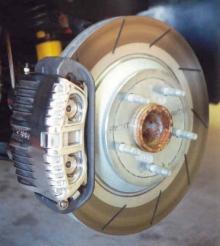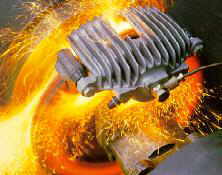
For good reading on brakes, I recommend Brake Handbook, by Fred Puhn
Wheels
 I'm
currently running racing wheels from CCW,
after my issue on the track with my Centerlines (see
below). I purchased 17x10 fronts (7.5"
backspace) and 17x11 rears (7.75" backspace), and will continue to
use Kumho Victoracers on them. These wheels weigh 20lbs apiece, the same
as the Centerlines did.
|

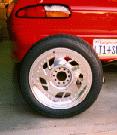 My
first set of aftermarket wheels on the Z28 were Centerline Saber 394 3-piece 17" wheels (by the
way, Centerline doesn't make their 3-piece billet wheels anymore), replacing the stock 16x8's. I'm
using 17x9.5 fronts, with a 7" backspace, and 17x10½ rears, with 7
3/8" backspace. I had the rears custom widened, since Centerline
doesn't make them this wide. The rear required flaring the
fenders, as it sits right even with the wheel, and when I drive with
the lowered springs, I'm sure would have hit. I also hit the inner
fenderwell just a bit with a hammer to give the tires just a bit more
clearance. I needed about an inch of total clearance before they
stopped hitting on hard turns.
My
first set of aftermarket wheels on the Z28 were Centerline Saber 394 3-piece 17" wheels (by the
way, Centerline doesn't make their 3-piece billet wheels anymore), replacing the stock 16x8's. I'm
using 17x9.5 fronts, with a 7" backspace, and 17x10½ rears, with 7
3/8" backspace. I had the rears custom widened, since Centerline
doesn't make them this wide. The rear required flaring the
fenders, as it sits right even with the wheel, and when I drive with
the lowered springs, I'm sure would have hit. I also hit the inner
fenderwell just a bit with a hammer to give the tires just a bit more
clearance. I needed about an inch of total clearance before they
stopped hitting on hard turns.
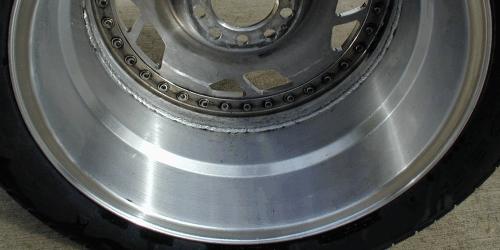
The wheels were widened by Erik Vaughn, in Southern California, (626) 358-6413. You can see in the picture above, this is done by cutting off and replacing the back half of the wheel. This means that the entire additional width is added to the backspacing for the new wheel - he can't add space onto the front of the wheel.
|
Fall 2001 update on the Centerline wheels: I broke the driver's front wheel, driving at the road course at Thunderhill. Fortunately, The wheel didn't crack completely through, and I only lost the wheel and a brake caliper, but this could have been quite deadly. I'm assuming it was a metal fatigue issue, as I didn't specifically hit anything. You can see the damage in the picture. Centerline was very good about the replacement, sending four new wheels, as well as paying for the caliper. While these were the older, lighter 3-peice wheels, and Centerline's new wheels are thicker and heavier, I'm a convert. If you're going to track your car, use the right wheels for the job. |
A note about weights: The rotating weight of a wheel and tire has a much greater impact on the car than a fixed weight. For that reason, it's very important to understand the weight of the wheel and tire combination you're using. As you move up to larger wheels and tires, it's very easy to add a lot of rotating weight, which can become really noticeable and make the car feel slow. The stock wheels are not only smaller, but they're actually pretty light, as compared to cheaper aftermarket wheels. So I suggest you at least check before you buy, and make sure you at least know what you're getting into.
For reference, a stock 16x8 5-point '97 wheel weighs 21lbs. My current CCWs weigh 20lbs each, for both the 17x10 and 17x11 models. With Kumhos mounted, the fronts weigh 46lbs, and the rears 52lbs.
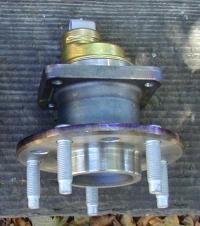 The
front bearings on the fourth generation f-body are sealed within the hub,
which is a single replacement part. It's an easy swap, I've documented it
in one of my install pages.
The
front bearings on the fourth generation f-body are sealed within the hub,
which is a single replacement part. It's an easy swap, I've documented it
in one of my install pages.
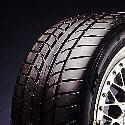 |
The first set of tires I used were BFG Comp T/A ZR Tires. For the money, these are at the top of the list of z-rated tires, other than some very high-priced tires. I have 245/45's for the front, and 275/40's for the rear. The Kumho Ecsta 712 is also a great tire for the money, and if you really want to go all out, look into the Bridgestone Potenza S-02, BFGoodrich G-Force T/A KD or Yokohama AVS Sports. |
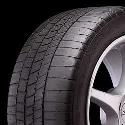 |
Currently, I'm using Kumho Victoracers, a road racing tire. These have low treadwear, and aren't good in the rain, but on a dry road they're killer. 275/40ZR17 on front, and 315/35ZR17 on the rear. |
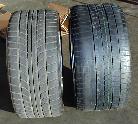
 In
the left picture you see the original Goodyear GSC
245/50 tire , and the BF Goodrich Comp T/A 275/40. In the right picture,
you see the same Comp T/A, and the Kumho 315/35.
In
the left picture you see the original Goodyear GSC
245/50 tire , and the BF Goodrich Comp T/A 275/40. In the right picture,
you see the same Comp T/A, and the Kumho 315/35.
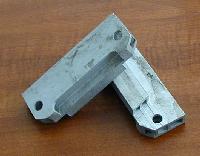
These are GM Jounce Bumper spacers, part 12363935, one of
the most misused mods on f-bodies. They install between the jounce bumper (the rubber
piece that stops the rear axle from coming up too far) and the body, and lower the jounce
bumper by 15mm. What do they do? Well for one, they limit suspension travel, which you
don't want. Your suspension should do that. Why would you use them, then? The only reason
would be if suspension travel causes your tires to hit your fenderwell before the axle
hits the stock jounce bumper. This is pretty rare, unless you're using huge
tires or your wheels have the wrong offset. Even at
that, first make sure your axle is centered correctly (and get an adjustable Panhard rod
to fix it) before you resort to the spacers. Unfortunately SLP Engineering recommends to
everyone that buys their 17" wheels that they use these spacers, and the net result
is usually just a reduction in the suspension's capacity to do its job.

If you want to stop quicker, you won't be able to do it with stock-sized replacement rotors, and while different pads will help a bit, there's going to be a limit to the amount of heat they can transfer through the rotors. To do it right, you want larger rotors, better pads (with more swept area), better calipers, and ducting to help cool the rotors. I opted for the front Baer Racing brakes, with polished 2 piston PBR calipers, zinc plated slotted 13" rotors (front only), and braided stainless steel lines (front and rear). They're the largest kit that would fit within my 17" Centerline wheels. I'd love to have a 4 or 6-piston Alcon caliper, but they're about 1.5" wider than the PBR.
First, these are the coolest things around! The rotors are so big, you can't even see the edge of them through the wheel. Which makes my polished calipers a bit hard to see, also :-( I know they're under there, and I'll just have to take my wheels off periodically to see them.
Seasoning the rotors, and bedding the brakes according to Baer's instructions is a bit of a pain. The process involves slowly increasing the temperature of the rotors - over THREE day's worth of mashing with increasing intensity on the brakes. Kind of exciting to get used to the brakes, but you must find a spot where people can get around you!
Anyway, after all that, my G-Tech results are decreasing the average 60-0 distance from 165 feet to 135 feet, about 20%. I haven't done lots of testing, but this is a pretty good gain.
Stopping distance from 60-0mph, 3 consecutive hard stops |
|
Stock Brakes |
Baer Brakes |
| 156, 164, 174 | 131, 134, 143 |
 |
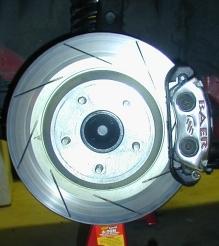 |
Summer 2001 update on these Baer brakes: I've been running on road tracks for a couple years now, and started to have an issue where the brake pads were dragging on the rotors. I called Baer, and they immediately recognized the problem and stated that the calipers have been "spreading" if used hard. That is, the two sides of the caliper are no longer parallel. They recommend I replace them with their newer caliper (the one on the right in the pic above). While Baer get me a couple bucks off on these calipers, I naturally wasn't thrilled that they weren't replaced at their cost.
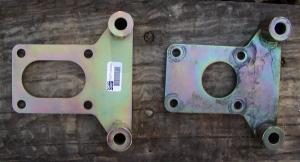 With
the introduction in 1998 of the LS1 f-bodies, GM changed the front wheel
hub slightly, moving the ABS sensor. The older style hub was discontinued,
and is becoming harder to find. Both hubs will fit on the stock spindles,
but do not fit in the Baer brackets. Baer is supplying new brackets as
folks need to replace their hubs. At left you can see the newer bracket
and the old bracket (with smaller hole).
With
the introduction in 1998 of the LS1 f-bodies, GM changed the front wheel
hub slightly, moving the ABS sensor. The older style hub was discontinued,
and is becoming harder to find. Both hubs will fit on the stock spindles,
but do not fit in the Baer brackets. Baer is supplying new brackets as
folks need to replace their hubs. At left you can see the newer bracket
and the old bracket (with smaller hole).
Rotors and Pads
If you use your car for any amount of time, or you race your car, eventually you'll get real good at replacing rotors and pads. For rotors, I don't recommend going real fancy. Get blank rotors for the cheapest setup, or get them plated if you don't like the rust that starts to form. I like the slotted ones, and avoid cross-drilled at all cost. I've found that KVR rotors, from FastToys are a very good deal. For pads, there are lots of options, and I certainly haven't tried too many. For street and road courses, I'm happy with the PFC "Street" pads, they're better than the PFC "Z-rated" pads. I just picked up a pair of Carbotech Panther pads, for race use only, and made one track event with them. I think they're better than the PFC Street pads, they were very nice.
Cooling
Brake cooling ducts are something dearly needed on the fourth generation f-body, if you're going to do any road course work. They're a pain to install, and cause lots of trouble, but I thought I'd give them a try. Here's the result...
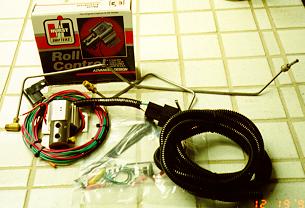
|
I installed the Hurst Line Lock and the Thunder Racing f-body install kit. This kit allows you to independently lock just the front brakes, leaving the rear wheels to spin. Nice clean burnouts are possible this way, including making shifts into second gear pretty easy. Installation: Essentially, the kit plumbs in to the brake lines, between the front lines and the ABS system. A switch in the cabin allows you to trigger a solenoid to "lock" the brake pressure in the front brakes alone. Thunder Racing gives you a great set of instructions, leaving you to screw it up on your own... I had some trouble with a bad ground, and I wanted to use a different switch, which didn't wire the same way. Plumbing-wise, you can see the lines below. From the solenoid, the line you see on the right goes to the rear port on the master cylinder, and the line on the left goes to the front port on the abs unit (and the stock line that connected the abs to the master cylinder is discarded). The other two ports into the solenoid are plugged shut.
|
|
Copyright © 1997-2004 David Mills, no part of this site (http://www.go-fast.org/) may be reproduced without permission of the author. The author makes no claims or guarantees as to the quality of the information on this site. I'm an enthusiast just like you, and while everything here is correct as I know it, I'm not responsible if your car breaks. |

















